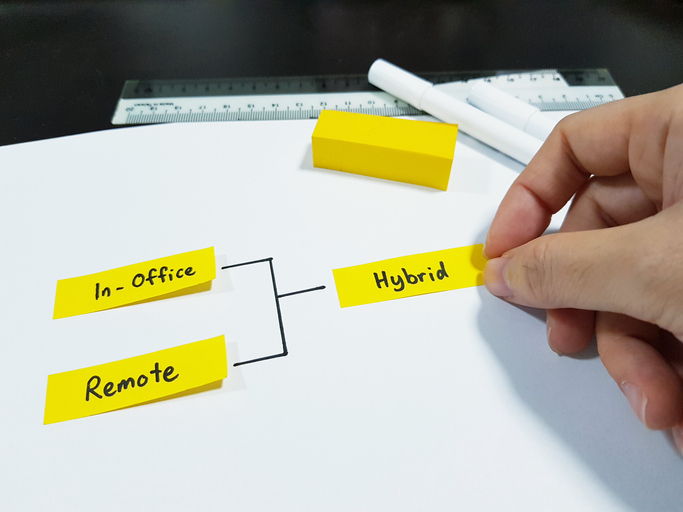For the past 24 months, we have been operating in a virtual environment for the most part. We have all had experiences trying to work this way, good, bad or indifferent. A recent NY Times article, “A Two-Year 50-Million-Person Experiment in Changing How We Work” talks about some of the issues associated with this strange new environment.
We are still sorting out the impact of a hybrid workplace
While the jury is still out on the virtual workplace, the NYT piece points out some interesting observations. Most tellingly, a study of 10,000 office workers conducted last year by the research group Future Forum suggests that “women and people of color were more likely to see working remotely as more beneficial than their white male counterparts.” So while an in-person office environment works well for a subset of individuals (white males), remote work is not the preferred environment for females and non-whites. Furthermore, the study reveals that 86 percent of Hispanic and 81 percent of Black knowledge workers (those who do nonmanual work) prefer a hybrid or virtual environment, compared with 75 percent of white knowledge workers.
According to the Times, this debunks the claim that “one size fits all” is an efficient way to operate in a work environment. Typically, workplace culture requires everyone to adapt to that culture’s norms, which brings comfort to most. The general expectation is that everyone else would just squeeze in.
Why does this fail? Primarily because we are not all the same. And as the above survey suggests, it is often easier for minorities to operate in a virtual environment because they are not driven by the group’s norms or their company’s corporate culture. Consequently, their differing social agendas often leads them to opt out.
Culture comes in different forms and each serves a different purpose
As a culture change expert, I get all this. It’s not difficult to understand, and I am undoubtedly sympathetic to the issues at hand. However, let us pick apart these points and see where this goes. Specifically, we need to consider the following:
- While we believe that people work better in non-tense/non-confrontational environments, there are some things which we give up operating in a virtual environment. People energize people and drive each other forward. We learn from one another. Collaboration is easier to achieve when we are all under one roof.
- Boundaries are better defined “in the flesh.” Understanding everyone’s roles works out better in person than in a virtual environment.
- Physically working in one spot makes it easier to observe and understand non-verbal feedback. These are critical to both the individual’s and the organization’s efficiency.
- We learn both formally and informally. Before jumping from one mode of work to another, we must evaluate which is more productive. Perhaps a hybrid environment brings out the best in workers, perhaps not.
- We are not all stamped from the same mold. While a significant portion of “work” is what we do, the personal interactions certainly affect the environment. For some, this is very comforting; for others, not so much. The virtual part of the hybrid experience can work well for those who might view themselves as outsiders, but might be less than optimal for ones who are social and like in-person sharing of ideas.
- The total learning experience could be compromised for those who seek an entirely virtual experience. Human interaction is part of our experience, a part of learning. The formality and informality of these learning experiences are very different in the workplace versus in a virtual environment. Learning the cues in face-to-face meetings is different from virtual experiences. Nothing is good or bad by itself, but a hybrid experience could be critical to success in many organizations.
- Learning to “love” your peers from afar is challenging. Gathering together to collaborate, bounce ideas each other, and even share jokes or talk about your weekend is very important and can cement relationships for future work efforts. Distance doesn’t always make the heart grow fonder.
The future of work is working now
Over the past 30 months, we have moved with relative ease from an in-person to a virtual environment. Today, as we move toward a hybrid way of working and the in-person workplace returns, we find ourselves in that uncertain time between what was during the pandemic and what is emerging now. Is this the future wave, or will we all be physically back in one place as the pandemic recedes? Or will we recognize that a hybrid environment encapsulates the best of both worlds and becomes the preferred future?
Most importantly, we must consider how all of this is crafting a new work-order for bosses, employees and society itself. How are you intentionally responding in your own workplace? How are you measuring the changes and the impact on you and your teammates? It is a time to change, as painful as change is for all of us.
What we do: Help you manage culture change so you can soar
As anthropologists, we have learned that the secret to people’s success is how they develop, inside and outside of their business settings. SAMC has developed a very successful approach to helping individuals and organizations attract and retain talent. We’d love to talk with you about how we can help your human development programs. To help organizations and individuals within those organizations become better leaders in these critical times, we regularly conduct leadership academies in many fields, across industries. We are also trained executive coaches, with a particular interest in supporting culture change initiatives focused on building diverse, equitable and inclusive organizations.
To get the conversation started, please contact us.
From Observation to Innovation,
Andi Simon, Ph.D.
Corporate Anthropologist | Author | CEO Simon Associates Management Consultants
Andisimon.com
Info@simonassociates.net
@simonandi
LinkedIn




